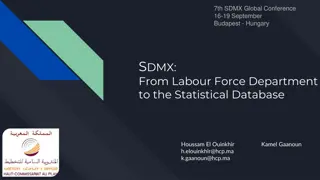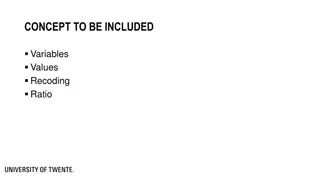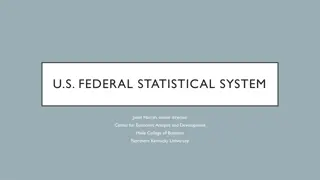Understanding SPSS - A Guide to Statistical Analysis
SPSS is a powerful statistical software widely used for data analysis. This guide covers the basics of SPSS, running descriptive statistics, modifying databases, transforming variables, computing variables, measures of centrality for quantitative variables, notation in statistics, and calculating means. Learn how to work with SPSS efficiently to analyze and interpret data effectively.
Download Presentation

Please find below an Image/Link to download the presentation.
The content on the website is provided AS IS for your information and personal use only. It may not be sold, licensed, or shared on other websites without obtaining consent from the author. Download presentation by click this link. If you encounter any issues during the download, it is possible that the publisher has removed the file from their server.
E N D
Presentation Transcript
BASICS What is SPSS? SPSS is a windows based statistical software package that works with other programs including spreadsheets, data bases, and word processors. 1. File 2. Open 3. Data
RUNNING DESCRIPTIVE STATISTICS 1. 2. 3. 4. Analyze Descriptive Statistics Descriptives... Choose YEARS_OF_EDUCATION Options 5. OUTPUT WINDOW: TO PRINT: File Export PDF
MODIFYING A DATABASE Apply Filters: 1. Data 2.Select Cases
TRANSFORMING VARIABLES Education Variable 0 Less than 12 years 1 HS Diploma 2 12 < education years<16 3 College Degree 4 Greater than 16 years 1. 2. Recode into Different Variables Transform
COMPUTING VARIABLES 1. 2. Compute Variable Transform EX: CAT_ED = 0
MEASURES OF CENTRALITY FOR QUANTITATIVE VARIABLES
NOTATION POPULATION (N): All the elements from a set of data. U1, U2, ..., UN SAMPLE (n): Consists of one or more observations from the population. y1, y2, ..., yn
MEAN (AVERAGE) Definition: It is the sum of individual scores divided by the number of individuals. A parameter is a measurable characteristic of a population. The mean of a population is defined as: U Note: The population total is defined as = N = i A statistic is a measurable characteristic of a sample. The mean of a sample is defined as:
EXAMPLE (MEAN) POPULATION (N = 6) U1 = 3 U2 = 1 U3 = 4 U4 = 2 U5 = 2 U6 = 0 SAMPLE (N = 3) y1 = 4 y2 = 3 y3 = 0 Formula for mean: Formula for mean: i U iy = (4 + 3 + 0) = 7 = (3 + 1 + 4 + 2 + 2 + 0) = 12 = 7 / 3 = 2.333 = 12 / 6 = 2
Years of Education in the Seminar Small Sample Data Set MEAN: 12.60
MEASURES OF DISPERSION (VARIATION) FOR QUANTITATIVE VARIABLES
RANGE In arithmetic, the range of a set of data is the difference between the largest and smallest values. Maximum = 20 Minimum = 0 Range = 20 0 = 20
VARIANCE Variance measures how far a set of numbers are spread out. Small variance data points tend to be very close to the mean (expected value) and hence to each other High variance data points are very spread out around the mean and from each other POPULATION: SAMPLE:
STANDARD DEVIATION Standard deviation (SD) is a measure that is used to quantify the amount of variation or dispersion of a set of data values. POPULATION: SAMPLE: 2 = = 2 = =
EXAMPLE (VARIANCE AND STANDARD DEVIATION) POPULATION (N = 6) U1 = 3 U2 = 1 U3 = 4 U4 = 2 U5 = 2 U6 = 0 SAMPLE (N = 3) y1 = 4 y2 = 3 y3 = 0 Mean = = 7 / 3 = 2.33 Mean = = 12 / 6 = 2 Variance = Variance = = [(4 2.33) 2 + (3 2.33) 2 + (0 2.33) 2]/(3 1) = 4.33 2 . 4 = [(3-2) + (1-2) + + (0-2) ] / 6 = 1.67 = = = 2 33 SD = = = 2.08 . 1 67 SD = = = 1.29
Years of Education in the Seminar Small Sample Data Set STANDARD DEVIATION: 3.062
HISTOGRAM 1. 2. Chart Builder 3. Histogram Graphs
HISTOGRAM NOT ACTUAL RESULTS 4. Drag Histogram chart to Chart Preview 5. Right click Years_of_Education to change to Scale 6. Drag Years_of_Education to X-Axis
INTERPRETATION OF STANDARD DEVIATION Empirical Rule: If histogram of a population of data is bell-shaped: + 1 contains about 68% of the data. + 2 contains about 95% of the data. + 3 contains about 99.7% of the data.
Years of Education in the Seminar Small Sample Data Set We would expect to find 95% of the observations between + 2 = 12.60 + 2(3.062) = (6.476; 18.724)
Z-SCORES A Z-Score is the distance between an observation and the mean expressed in units of the standard deviation.
Years of Education in the Seminar Small Sample Data Set If the value of Years_of Education is 16, it s Z-Score is: U = = Z Z 16 12 60 . . 1 = 110 . 3 062
DESCRIBING A QUALITATIVE VARIABLE
DEFINITION AND NOTATION Qualitative variables have values that represent categories. The parameter that is generally of interest is the proportion of items in the population that have a particular characteristic of interest (i.e., are in a particular category). Example: The proportion of claimants with at least a high school education. POPULATION: SAMPLE:























